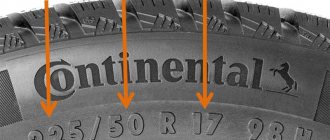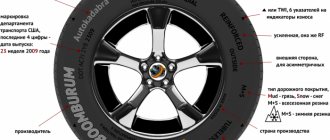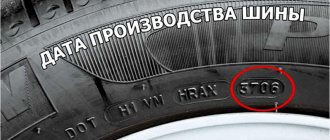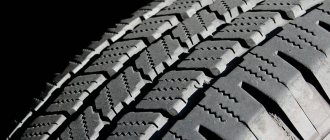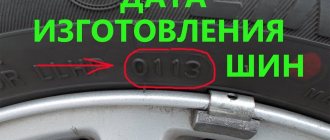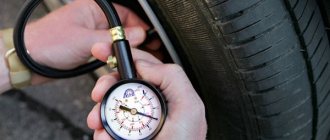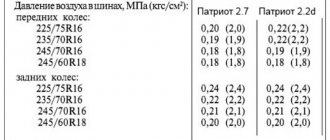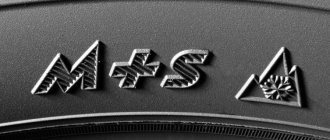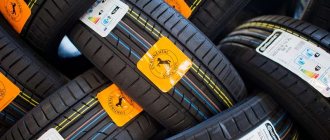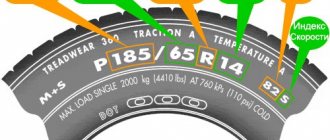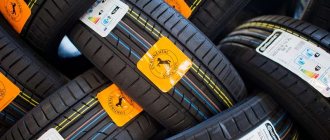Are you looking for what tire markings mean and what their designations mean? In the article you will learn what the numbers and letters of car tire markings mean and a complete explanation of the remaining symbols on car tires for 2022.
R13 means the diameter of the rim, 155 is the width of the tire in millimeters, 70, in turn, means the profile, that is, the height of the rubber. This is a percentage of the tire width, i.e. 155 mm * 70% = 108.5 mm.
Tire markings - interpretation for passenger cars
At the moment, metric tire markings are used, which we will consider using the example of the P 205/65R16 91H tire marking, the decoding will be as follows:
- P - optional index indicating the purpose of the bus
- 205 – width of the tire profile (i.e. the contour of the tire in the radial plane of the wheel), indicated in millimeters
- 65 - the ratio of the height of the tire profile to its width, indicated as a percentage
- R - letter index indicating the type of tire
- 16 - tire mounting diameter corresponding to the diameter of the rim of the car, indicated in inches
- 91 - load index
- H - speed index
Full explanation of tire markings
Become familiar with all the markings on car tires used by tire manufacturers. Find out how to find out the size and date of manufacture of tires, what are the load and speed ratings, and what is a tire with the M+S designation? See where you can find information about protective rims. We have dispelled all doubts related to the markings on the tire.
Correct reading of the markings ensures the best choice of tires and their subsequent trouble-free operation. In this article, we will clearly explain the meaning of the mysterious symbols you may find on tires.
The most common markings on tires are:
- Tire size
- Speed index
- Load Index
- 3PMSF
- M+S
- Protective Edge
- Tire reinforced
- Date and place of production
- Asymmetrical tire
- Directional bus
All tire markings (in alphabetical order): # B C D E FG N IJKLMNOPRSTUVWXYZ
Additional information related to tire markings:
- Tire labels
- How to distinguish winter tires from summer and all-season tires?
- UTQG marking (TEMPERATURE, EQUIPMENT, TRACTION)
Explanation of tire marking designation
- Tire width in millimeters
- Profile height as a percentage of width
- Letter designating the tire design (R - radial, D - diagonal, B - belt
- Rim diameter in inches
- Load index (coefficient) that determines the maximum load on the tire at which it will not collapse
- Speed index, which determines the maximum speed for which the tire is designed
- The presence of the word REINFORCED or the letter C indicates a reinforced tire carcass
- Manufacturer country
- Indication of the side for asymmetrical tires, OUTSIDE is the outer side of the tire, INSIDE is its inner side
- Adaptability of the tire to special operating conditions, M&S (M+S) - mud and snow, AS (All Season) - all-weather, AW (Any Weather) - any weather, Aquatred, Aquacontact or an umbrella pictogram - special rain tires, Pictogram in in the form of a snowflake - tires for winter, lack of any markings - tires for use only in the warm season
- Certification mark
- TUBELESS - tubeless tire, TUBE TYPE or no inscription - tire with a tube
- Tire design details
- Manufacturer's company name or logo
- Tire model
- Maximum load and pressure
Manufacturer and model information
In addition to the size, the brand name and model are printed on the side to identify the tires, for example: Nokian Hakka Green, Michelin Energy, Toyo Proxes, Good year Ultra Grip, Belshina BEL-347, Amtel NordMaster, Hankook K415 Optimo and others.
The inscription “ Made in... ” indicates the country of manufacture (Russia (Russia), Germany (Germany), USA (USA), France (France), China (China), etc.).
The year and week of manufacture on the tires are marked in a rounded oval with four numbers: for example, “0915” would mean that the tire was made in the 9th week of 2015.
What do the symbols on the bus mean?
195 — tire width in millimeters.
50 - the value expressed as a percentage means the ratio of the height of the side of the tire (the place where we found information about the tire size) to the width. In this case, the value "50" means 50 percent of 195 mm or 97.5 mm.
R - radial design, a type of tire construction.
15 - the diameter of the seat, which is also the diameter of the rim, given in inches. 82 T is a load index with a value of 82 and a T class speed index (you can read the indices below).
C - designation of the delivery tire.
Speed index. The speed index is a sign that tells you the maximum speed you can drive on a given tire. You will find it on the side of the tire, at the end of the size sign. ATTENTION! For winter tires, you can use a lower speed than the manufacturer's recommended speed.
Compliance
Tires produced in the CIS countries and Russia in particular have inscriptions indicating that they comply with state standards or certain technical conditions. On the sidewall they are applied with the document code, for example: GOST 4754-97 or TU2521-036-00148984-98. In addition, tires certified in Russia are sometimes marked with the PCT mark, which indicates the presence of a certificate.
Tires intended for the European market are embossed with a sign of compliance with UNECE rules N30. The number in the circle is the country code, and the one outside is the designation of the standard, for example E4 0220984.
Tires produced for the North American market are marked DOT (Department of Transportation USA), which consists of an alphanumeric code that encrypts the manufacturer, the size of the slope, and the manufacturing plant, for example, DOT M746 JR1R.
Load Index
The load index is another important mark on the tire. Indicates the maximum permissible load on one tire when driving at maximum speed. It is strictly forbidden to use tires with a lower load rating than recommended for a specific vehicle model. For example, a tire with a load index of 91 can be subjected to a maximum load of 615 kg. If you multiply this value by the number of tires on the car, you will get a result that is slightly higher than your vehicle's maximum fully loaded gross weight (you can read this in the F1 field on your registration certificate).
The most common load indicators:
All tire markings (in alphabetical order)
3PMSF is a symbol confirming winter tire properties found on winter tires and all-season tires.
3PMSF symbol on the bus. B Designation
BasePen - The tire is electrostatically grounded (a groove running through the center of the tread contains a silica mixture that dissipates electrical charges).
BLT - (Raised Black Letters) black and raised letters. Designation BSW - (black sidewall) inscriptions on the tire in black.
C - COLD marking - this is information that the pressure is measured on cold tires. You will find the tire's production date at the end of the DOT number.
D - DOT - (Department of Transportation) tire property designation meets all safety standards of the US Department of Transportation. The mark is adjacent to the 12-digit identification code or serial number of the tire. At the end of the DOT number is the date of manufacture of the tire. Tire release date—indicated at the end of the DOT number. The picture shows the Matador tire released in week 42 of 2008. Tire age information is also on the side. Look for a tire identification number that begins with the letters DOT. This is a string of 7 to 12 characters long, informing about the entire batch of tires produced at this plant. The last four digits of this code (most often located on the border) contain information about the tire production date. For example, 4208 - the first two digits are the week of production, the second two are the abbreviation of the year, that is, the tire was released in the 42nd week of 2008. Designation DSST - Dunlop RunFlat tire.
E - Designation ECE, e, E - abbreviation for Economic Commission for Europe means European approval. EMT (Extended Mobility Tire) tires allow you to drive even after the pressure drops to zero.
F - Designation FP - (Fringe Protector) or RFP (Rimb Fringe Protector) tire with rim protection. Dunlop uses the symbol MFS. The FR marking is a tire with a protrusion to protect the rim from mechanical damage. Most often found in tires with a profile of 55 and below. This depends on the specific manufacturer, as well as the type and size of the tires. Examples of sizes where ribbed tires are the most common are: 205/45R16, 195/50R15, 205/55R16 (there are exceptions). Less common for sizes: 145/65R15, 235/70R16 (in SUVs). FR markings do not appear on tire sidewalls.
and - Signs outside and inside - symbols used in asymmetrical tires, indicate which side of the tire should be installed inside, in the direction: towards the car, towards the hub with the rim. The inside side of this tire should not be visible from the outside of the vehicle.
J - Designation JLB - (Jointless Band) endless tape made of nylon.
L - Marking LI - (load index) indicator that determines the maximum load capacity of the tire.
LT - (Light Truck) marking indicating that the tire is intended for 4x4 vehicles and light trucks (used in the USA). This happens down to the tire size.
M - Marking MAX - maximum or maximum tire pressure.
The M+S (Mud and Snow) designation is mud and snow used as a designation for winter, all-season and SUV/SUV tires; often found even on tires from Europe; This designation is only a declaration of the manufacturer, it is not an official symbol confirming the winter properties of the tire.
The M+S marking is found not only on winter and all-season tires.
Marking MFS - (Maximum Flange Shield) - rim protection; Some winter tires have a protective edge on the rim, called a wheel tread. The purpose of the rim is to protect the edge of the rim from mechanical damage that may occur, for example, when approaching a curb or getting caught in an object. There are different names for rantings, depending on the tire manufacturer.
The most common non-MFS are: RFP (Rim Fringe Protector) marking, FP (Fringe Protector) marking - rim protection, FR (Felgen Ripen) marking - rim protector.
o - Designation OWL - (Circled in white letters) in white letters. EXTERNAL SYMBOL - used on asymmetrical tires, denotes the method of tire assembly. Outside means that the side of the tire with this mark must be visible from the outside of the vehicle after the wheel is installed on the rim.
P - Designation P - (Passanger) symbol is placed in front of the tire size. This means that the tire is designed for passenger cars (used in the USA). The PAX marking is a zero-pressure Michelin tire with a stable inner ring. Designation PSP-Beta - the tire has a design that is characterized by overlaps to reduce noise levels.
R - Marking R - (radial) radial tire.
RBL markings are (recessed black letters) concave black letters.
RETREAD marking - retreaded tire.
The RF designation is an abbreviation for reinforced English; describes a reinforced tire with increased load-bearing capacity (load-bearing capacity). It has the same meaning as for tires with the XL symbol. Other designations for reinforced tires are, for example, EXL, RFD, REF, REINF. RFT - Run Flat Tires, Run Flat tire, used in Bridgestone, Firestone, Pirelli. RIM PROTECTOR marking - the tire has solutions to protect the rim from damage. The rim protector prevents damage to the rim due to impacts or abrasions, such as on a curb.
ROF is a "Run On Flat" symbol used by Goodyear and Dunlop to mark tires that allow tires to continue driving after tire failure without air pressure inside. ROTATION marking - always with an arrow, indicates the rolling direction of the tire used in directional tires. The ROTATION indicator informs you about the correct way to install the directional bus.
RSC Marking - Abbreviation for Run Flat System Component. This occurs on tires compatible with the run flat system used in BMW vehicles. Designation RWL - (Raised White Lettering) raised white letters.
S - Designation SST - (Self Supporting Technology = RunOnFlat) a tire that allows you to continue driving even after a breakdown, when the pressure inside is zero. SI - (Speed Index) designation indicating the upper limit of the permissible speed of use. T Designation TL - (tubeless tire) tubeless tire. Designation TT - (tube tire type) dętkowa tires. The TWI designation is an abbreviation for the English Treadwear Indicator. The TWI marking is found in six places around the tire circumference (in the form of ridges in the tread grooves) and indicates the permissible wear limit of the tread pattern. When the tread wears to the TWI level, it means the tire has reached the legal depth of 1.6mm. Then you should consider replacing the tire.
U - Designation ULW - the tire has a construction that uses aramid cords.
B - Designation VR or ZR - speed indicators are woven into the tire size. The VR and ZR markings indicate that the tire can be used with full load capacity up to the specified speeds: VR - up to 210 km/h, ZR - up to 240 km/h. For example: 225/45 ZR17 91 W means that the tire can be used with full load up to 240 km/h, and the maximum speed for this tire is 270 km/h.
X - Mark XL - (Extra Load = RF) tire with reinforced structure and increased load capacity. Reinforced tires have a special design that allows them to be used with greater loads.
c - Designation ZP - Zero Pressure, Michelin tire for descent.
Additional information related to tire markings
Tire label From November 1, 2012, on every tire manufactured after June 30, 2012, a label must be found informing about the main characteristics of the tire. It has 3 parameters: rolling resistance, which affects fuel combustion and CO2 emissions, wet grip, which gives an idea of the overall level of safety provided by the tire, external noise level, which affects the overall road noise level.
The labels give a general idea of the tire's characteristics, but do not contain many important parameters, such as the basic characteristics of winter tires. Don't completely trust the label when making a tire purchasing decision.
American system
US companies label their products differently than European companies.
Two types of marking systems are relevant for them:
- augmented European;
- authentic.
The first is very rare and is based on the familiar European one with a small addition - indicating differences in purpose. The required sign is located in front of the standard size. There are five letter combinations in total.
| Designation | P | LT | ST | LRO | T |
| Passenger | Light Truck | Special Trailer | Low Platform Trailer | Temporary | |
| Purpose | For passenger vehicles | Suitable for vans and small trucks | Trailer | Low platform trailers | Temporary replacement |
The second system is more complicated at first glance. But experts and experienced drivers claim that it is more logical and informative. The combination uses three types of digital characters and one letter designation. They need to be decrypted as follows:
- 1st number – outer d;
- 2nd number – width;
- letter - construction;
- 3rd number – internal d.
All dimensions are given in inches, but these markings are easy to read. Let’s assume that the buyer saw 31×10.5 R15 on the product. It means that:
- outer diameter will be 31;
- tire width – 10.5;
- radial type;
- internal d – 15.
Additionally, brands from the USA indicate the temperature range. It has 3 gradations:
- A;
- B;
- C.
The most reliable and practical is the tire with the first mark on the list. It means that rubber does not lose its properties even when used at extremely high temperatures.
The braking index is measured and designated in the same way.
If the buyer sees the letter A, then he can be sure of excellent grip on wet or icy roads.
Americans also put down a mark reflecting the possible mileage. It is measured in numbers starting from 100. A hundred is taken as the initial value - 48 thousand km. Lower mileage is not found on tires from companies from the USA, as this does not meet quality standards.
How to distinguish a winter tire from a summer tire?
Winter tires have M+S (Mud+Snow, Mud+Snow) on the side of the tire and a three peaks symbol with a snowflake inside. Sometimes there is no M + S sign on the tire, but there is a symbol with a snowflake - this also means. that the tire is intended for the winter season.
It is a little more difficult to distinguish a winter tire from a year-round tire. Tires of this type, found in Europe, are usually identified by a snowflake with an M+S symbol. The differences are visible in the tread. In the case of an all-season tire, it has fewer cuts and grooves than a typical winter tire, but more than a summer tire. Some models have an asymmetrical tread pattern: half is responsible for summer performance (summer tread with fewer bars), and the other for winter performance.
All-season tire model names often include phrases that indicate good performance throughout the year, such as "All Season", "Quatrac", "Quadraxer", "4 Seasons", "All Weather", etc. Some manufacturers also have your own year-round tires - these are usually symbols that allow you to easily identify the type of tire you're dealing with.
Watch out for tires that have the M+S designation without the snowflake. These may be products imported from the US, where most tires carry the M+S designation, but have nothing to do with all-season or winter products.
In European realities, all-season tires are similar to winter tires, so they most often have the symbol of a mountain with a snowflake. The M+S marking may also appear on 4x4/SUV tires regardless of their season. In conclusion, the mountain symbol with a snowflake means that the tire will perform well in typical winter conditions. UTQG marking The UTQG marking (Uniform Tire Quality Grading) applies mainly to passenger tires from the US market, but they can also be found in Europe (this model may fall into both markets). They are not officially used on our continent, so manufacturers and sellers do not report their meaning and cost for these models. This type of marking can be found on the sidewall of the tire in the form of subtitles with specific meanings: TREADWEAR - abrasion resistance of the tread, TRACTION - tire grip on wet roads, TEMPERATURE - tire resistance to overheating. tread wear.
To explain this concept well, the definition of a comparison bus should be mentioned first. This is a standardized model whose parameters correspond to the TREADWEAR 100 index. TREADWEAR values can appear on tires for sale in multiples of 20 (60 - 80 - 100 - 120 - ... 200 ... 800).
How are they distributed? The test is conducted under controlled conditions on a designated route of 6,400 miles or approximately 10,300 kilometers around Goodfellow Air Force Base, San Angelo, Texas.
The tested tires are installed on a specially prepared car together with tires with an index of 100, and then the consumption is compared. Its level is measured every 800 miles (1,287 km). Based on the measurement results, tires are given an index, such as 60, 100, 200 or 400. If a tire receives an index of 60, its theoretical durability is 60% of the comparison tire (index 100).
As a result, a tire with an index of 60 will wear out almost 2 times faster than a tire with an index of 100. In turn, a tire that receives an index of 200 will wear out 2 times slower than a comparison tire, and 2 times faster than a tire with an index of 200. index 400. A model with an index of 400 will be 4 times more durable than a comparative product (with an index of 100).
TRACTION Adhesion under UTQG marking is expressed by letters. The highest rating is AA, followed by A and B, and the lowest is C. This rating gives the driver information about the tire's ability to stop the car on wet roads.
The TRACTION parameter is determined on an asphalt or concrete path under strictly defined conditions. The test car accelerates to a speed of 65 km/h, then brakes. During the test, the vehicle's ABS system is disabled. In Europe, the lowest allowed TRACTION value is A. If someone prefers a dynamic and aggressive driving style, it is worth looking for tires with the AA index. Indices B and C are acceptable only in American conditions, and in Europe it is better not to buy such tires.
It should also be noted that the TRACTION marking does not indicate dry adhesion, flexure or hydroplaning resistance.
TEMPERATURE
The last of the UTQG designations is TEMPERATURE, which determines the tire's resistance to overheating, that is, the temperature created while driving. When driving at high speeds, the tire becomes very hot, which can shorten its life. Laboratory tests are carried out to isolate the index (possibly A, B and C, where A is the best value). Resistance to overheating is very strongly related to the speed index. Therefore, for the A mark, a 30-minute test at 115 mph (185 km/h) must be completed to obtain the B mark, at a 30-minute test speed of 100 mph (160 km/h) for both the tire and index C The tire must pass the test at 85 mph.
TRACTION (adhesion) and TEMPERATURE (overheating) markings in Europe must be at least A. TREADWEAR (wear resistance) will help you choose tires with a longer service life. If you want to take these signs into account, remember that the difference between tires with an index of 200 and 400 will be significant. However, UTQG markings should be considered as an overview only. There is no need to use them in Europe and the values are determined based on North American conditions.
Tire markings must be applied to the following tire manufacturers:
Amtel, Belshina, Barum, Bridgestone, Continental, Cooper, Cordiant, Dayton, Debica, Goodyear, Dunlop, Falken, Firestone, Fulda, General, Gislaved, Hankook, Kama, Kelly, Kleber, Kormoran, Kumho, Marshal, Matador, Maxxis, Michelin, Nitto, Nokian, Pirelli, Sava, Semperit, Tigar, Triangle, Toyo, Uniroyal, Yokohama. This tire marking is valid from 2022.
Wear indicators
The locations of critical tread wear marks on Continental tires are indicated by the letters TWI. On summer models they are supplemented with indicators with cross and drop marks. They signal that the tires have not yet reached the minimum tread height, but it is no longer enough to feel confident in the rain.
There are also VAI indicators on the tread. They are applied symmetrically in the left and right shoulder areas. If the wheels are installed correctly, they change exactly the same as the tires wear out. Discrepancies are a reason to visit the wheel alignment stand. So far, the technology is used only on truck tires.
